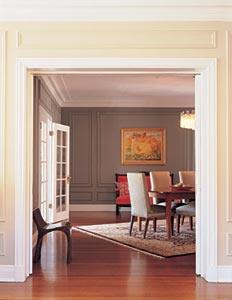Photography by Kate Roth
Styling by Arden Nelson
 |
When you visit the home of someone whose business is fashion, you expect to be astonished. Unusual colors, one-of-a-kind accessories, great fabrics-who knows what you’ll find? But the East Lake View home of fashion editor Stacy Wallace-Albert, while clearly belonging to someone with an eye for color and line, doesn’t startle. Rather, it feels invitingly livable, more like a soft cashmere sweater than a pair of sharp-toed Manolo Blahniks.
The seemingly effortless look is actually the result of years of planning. Wallace-Albert and her husband, Wayne, bought the three-bedroom apartment-on the top floor of a 1925 building-15 years ago, drawn by its period details and spacious layout. “You can stand in the living room and see into four other rooms,” says Wayne. “It’s not a tunnel.”
When it came to decorating, the couple had to start almost from scratch. “When we got married, I lived in a tiny apartment in the city that was full of clothes,” Wallace-Albert recalls, laughing. “And he lived in a house in the suburbs that was full of art.”
Chicago magazine’s style/shopping editor, a contributor to Chicago HOME, and founder of a fashion Web site (www.thefashioneditor.com), Wallace-Albert says she and her husband decided to create their dream home themselves, tackling renovations in stages and collecting decorative pieces during their travels. “Most of the things here we found together,” says Wayne. “You can hire a decorator and say, ‘Do it all.’ But every little tiny piece in here is from us.”
Wallace-Albert is especially inspired by Parisian style, and fond of interiors that look “loved”-i.e., a little worn. “There’s no charm in perfection,” she says. “French design has a timelessness to it. It can be sophisticated but also very charming and comfortable and welcoming.”
She is open-minded about mixing pieces of different periods and price ranges. “We don’t care about provenance,” she says. “We only care about a piece’s value for us. I’m buying for now, not the future.” By focusing on harmonious colors and shapes, the home blends gallery-worthy collectibles, refurbished flea-market finds, and pieces from mass-market retailers such as Pottery Barn.
In the living room, a Venetian glass mirror from the 1940s hangs above a Mies van der Rohe glass coffee table; in the corner, a string of Japanese lights with rice-paper shades fills a French metal birdcage. Wallace-Albert points enthusiastically to a wood side table with sinuously curved legs that she bought for $75 at The Bombay Company (“I saw one that looked just like this at a local antique shop for $1,200”). Another proud find is the 1920s Wilton carpet with a bird-of-paradise pattern, snagged for around $300 on eBay.
Since Wallace-Albert and her husband like to entertain, the dining room had to be dinner-party-friendly. The custom-made cherry table was designed in the style of a French kitchen work table and made with vintage tools; the rustic look can withstand the odd scratch or spill. The table and rug are set at an angle, giving the room an added visual punch.
Wallace-Albert says people shouldn’t be afraid to consider custom-made furniture; she had a living-room settee made for only slightly more than she would have paid for a vintage piece (and about one-third of what she would have paid at a Merchandise Mart showroom). “It’s great when you have a specific space to fill because you can choose the measurements and proportion,” she says.
Overhanging the table is a true collector’s item: a 1950s chrome-and-glass chandelier that once hung in the apartment of Eppie Lederer, a.k.a. Ann Landers. Wallace-Albert and her husband spotted it at the architectural resale shop Salvage One. “It was very faded from years of cigarette smoke,” she says, “but we decided to buy it in about 30 seconds.”
The blending of old and new continues in the warmly inviting kitchen, designed by architect Elissa Scrafano, where a gleaming professional Thermador stove stands opposite a rustic table and an oversized, farm-style sink. “I don’t need diamonds,” observes Wallace-Albert. “What I wanted was a great big honking stainless steel stove.”
An enthusiastic cook, she refers to the kitchen as Girlfriend Central, where friends often stop by for a bowl of soup or glass of wine. That factored into her countertop choice: she considered limestone, but “you can’t seal it properly and we drink a lot of red wine!” she says. She ended up choosing unpolished granite instead.
Adjacent to the kitchen, a former breakfast nook was turned into a cozy sitting area. Wallace-Albert transformed two French chairs from the 1940s (discovered at the Sandwich Antiques Market-$15 for the pair) by painting the wood a glossy black and covering the seat backs with paisley shawls; the seat bottoms were upholstered in red leather. Overlooking the nook is a Cezanne-inspired still life Wayne spotted for sale at a gas station on Ashland Avenue-a place the couple now jokingly refers to as “Galleria Gazoline.”
In contrast to the eclectic look of the rest of the apartment, the master bedroom is an almost monochromatic vision of white and ivory. Flashes of whimsy include two leopard-print stools and a mirrored dressing table.
White is also the dominant color in the guest bedroom, which Wallace-Albert calls the “B & B room.” White wood paneling covering the walls gives the space a rustic feel, and the bed linens were chosen for their simple, handcrafted look.
Although the home is not quite finished (next up: a makeover for Wallace-Albert’s home office), the couple say they’ve created a space that truly reflects who they are. “I’ve had people walk in here and say, ‘It looks just like you,'” says Wallace-Albert.
Clearly, a compliment.


